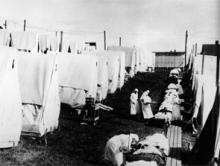Apocalypse, pestilence, death. As I head back to work after a late-summer vacation, those words are on the tip of my tongue. Now before your mind drifts too far afield, this is not a synopsis of the time spent with family, or even my in-laws—although some have used similar words to describe my mother’s cooking. Rather, these are the descriptors of my vacation reading.
Summer Reading
I started the week relaxing contentedly with Cormac McCarthy’s “The Road.” I chose this book in part because I noticed that it soon will be released as a movie, but mostly because it had won the dustiest-book-in-my-office-reading-pile award. This tale of a young boy and his father traversing a post-apocalyptic America was shocking and surreal. I couldn’t help but interchange images of my 2-year-old son, Greyson, and me out on that road fighting for our existence. In my personal fictional account, I continuously, and heroically, MacGyver my way across a burned-out and treacherous landscape with death-defying adeptness—all the while Grey unknowingly totters, drooling and muttering in tow.
Reality, of course, would paint us in substantially different roles, with mine involving the lion’s share of muttering and drooling, leaving Grey wishing the apocalyptic dealer had dealt him his mother instead.
Next up, “The Last Town on Earth,” by Thomas Mullen. I don’t recall how this book got into my reading pile, but I’m glad it did. The story is set in the fictional city of Commonwealth in 1918. The small, isolated mill town makes the drastic decision to stanch the tide of Spanish flu by cutting itself off from civilization through a self-imposed quarantine.
It is here, on p. 98, that I was sidetracked by a family member’s question—“Do you think this swine flu will be as bad as the Spanish flu?” I was asked shortly after being inquired about my reading choice. “Of course not,” I replied knowingly, moments before realizing I didn’t know. In fact, I didn’t have the faintest idea—not because it’s tough to divine the future, but because I realized I had little more than a passing knowledge of the famous flu that raked the world early last century. And with that, I was off on my final vacation reading session—a quest to slake my thirst for influenza knowledge.
Flu Pandemic
The Spanish flu pandemic of 1918-1920 was the first of three to hit in the 20th century. It took its name not from its site of origin (debated but generally felt to be the U.S., Kansas specifically), but rather from the fact that Spain, a neutral country in World War I, had the most uncensored lines of communication, so the most credible news of the disease came from that country. This provided the false impression that Spain was the only—or at least most dramatically—affected country. Like today’s swine flu, the Spanish flu was an H1N1 influenza. To sate your inner microbiologist, this means the virus exhibits the first of 16 subtypes of hemagglutinin (H) and nine subtypes of neuraminidase (N). Generally, only H1, H2, H3, and N1 and N2 affect humans, and tend to cause mild disease in otherwise healthy populations, killing the immunocompromised, the very young, and the very old. This typically results in a case-fatality rate of about 0.1% and 250,000 to 500,000 deaths worldwide annually.

